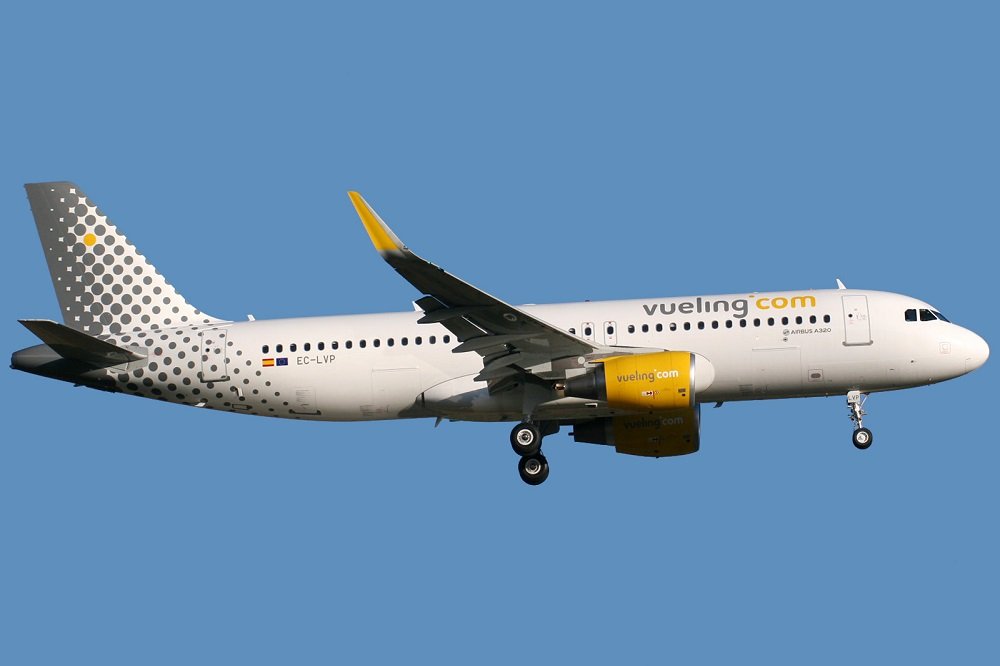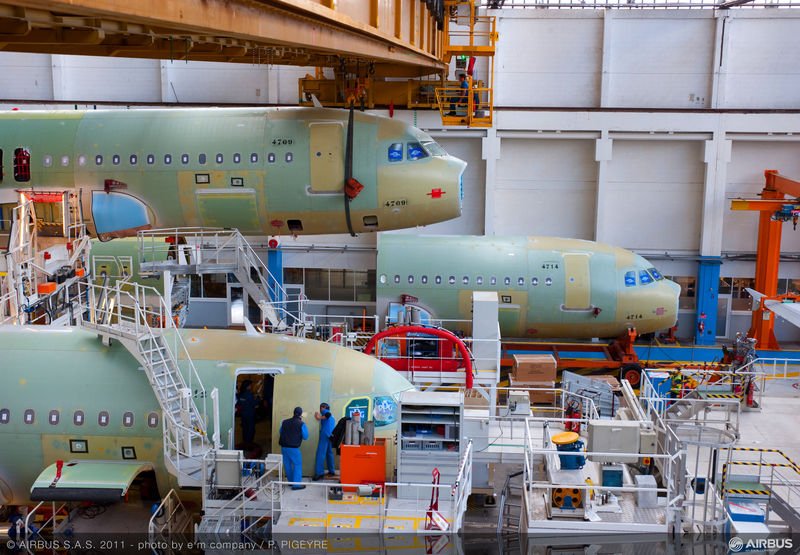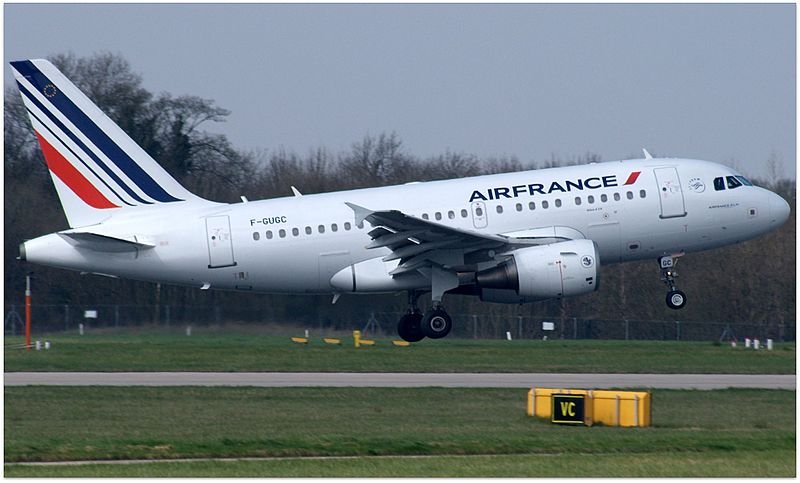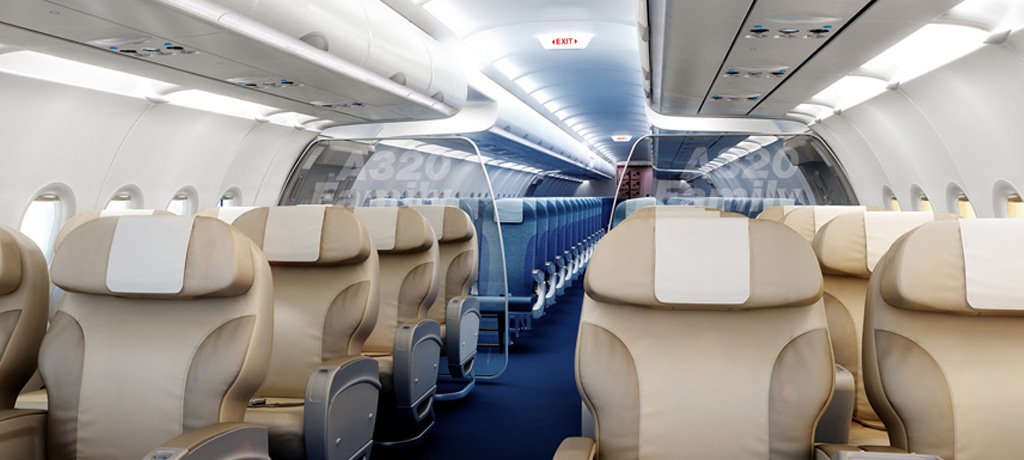
Airbus A320
SPECS
ASSEMBLY
INTERIOR
HISTORY
ORDERS
Airbus Industries A320
Airbus launches the A320 with Sharklets. Sharklets are what Airbus calls the winglets designed to give extra lift and therefore better fuel economy.
The Airbus Industries A320 jet family of airplanes consists of four different variants; A318, A319, A320, and the A321. The Airbus A320 seating layout was Airbus' first narrow-body offering in the single-aisle, short to medium-range market. The A320 was the first of this family to be produced and first flew on 22 February 1987.
In the A320, Airbus pioneered the fighter-style side stick for flight control. This was all part of the fly-by-wire that was also pioneered in this airplane. Fly-by-wire replaced manual connections between the controls and the flight surfaces with electric wires that transmitted electronic signals from the pilot's flight controls through a computer to actuators which physically moved the surfaces. This system enabled more fail-safe systems to be built into the aircraft so that pilots could not put the aircraft into situations that were dangerous to flight safety. In addition, the weight saving of using electrical wire instead of heavier cables was also a benefit to the economy of the aircraft.
Airbus needed an airplane to break into a segment of the airline market where previously they were absent. It was set to compete head-to-head with Boeing's 717, 757, and 737 as well as McDonnell Douglas' MD80 and MD90. Between 2005 and 2007 the A320 family was the fastest-selling jet airliner family.
Airbus A320 NEO
In 2006, Airbus began a program of improvements for the A320 family. The A320NEO (New Engine Option) or A320E (A320 Enhanced) are targeted at bringing the A320 into the modern age with improvements around fuel efficiency, environmental considerations, and passenger comfort. These improvements include new winglets or Sharklets as Airbus prefer to call them, which will enhance the aerodynamic performance. These, along with weight savings will reduce fuel burn, always a very important consideration in today's high-cost fuel environment.
A new cabin layout with increased carry-on luggage storage space and as well as an improved air purification system will be a winner with passengers. Being used mainly as a short-haul commuter jet, the trend today is for passengers to travel with carry-on luggage only, so cabin baggage space is an important factor.
As the name A320NEO suggests, the new jet offering will come with engine options of either: CFM International LEAP-X or Pratt & Whitney PW1000G. These new generation engines will deliver savings in fuel as well as a reduction of Nitrogen Oxide output in the region of 10%. The fuel saving will offer an average of 500 nautical miles of extra range over current offerings.
Initial production of the Airbus Industries A320 jet airliner was postponed due to a disagreement between the partner countries; U.K., France, and West Germany. Each wanted to have a greater role. These "Work Share Arguments" centered around prestige as well as money. In the end, it came down to how willing the respective governments were to subsidise their aerospace companies. In March 1984 an agreement was reached and production began with 96 airplanes ordered from 5 carriers.
The graphic on the left, courtesy of Airbus, best describes the international collaboration required to produce one A320. From places like; Mobile Alabama to Saint Nazaire France, Hamburg Germany, Getafe Spain, Taijin China, and Broughton UK, parts are created to be sent to the various assembly plants. Transportation is by road, roll-on, roll-off ships, train, and specially built Beluga air transporters.
ASSEMBLY
The graphic shows the international collaboration required to bring together the Airbus A320.
As with any modern airplane, the construction of various components is spread across dozens of companies from many countries around the world. They range from makers of fasteners, adhesives and ball bearings to fuselage sections and wings.
To enable the A320 to be quick to market, Airbus has built factories in Toulouse, Hamburg, Mobile Alabama, and Taijin China.
Toulouse is responsible for assembling A320s, whilst Hamburg assembles A318s, A319s, and A321s. Taijin in China produces A319s and A320s, while Mobile Alabama assembles A319s, A320s, and A321s, under the name of Airbus U.S. Manufacturing Facility.
Wings made in China are attached to the fuselage of the Airbus A320.
An Airbus A320 for Air China nears completion in the Tianjin, China factory.
The fuselages arrive at the assembly plants by either Beluga aircraft in the case of Hamburg and Toulouse or container ships in the case of Taijin and Mobile. The forward section is built in France whilst the after section is built in Germany. At the assembly plant, they are first moved to Station 41 where the two parts are joined together and so the process begins.
From Station 41 the joined fuselage is then moved to either Station 40 or 35 which both perform the same function. The wings that were manufactured in the UK are then joined to the fuselage as are engine pylons, landing gear, and other main components. Next, the emerging aircraft is moved to a multi-purpose bay where internal systems and cabins are installed and fully tested. From here they complete pressure testing, fuel testing, engine installation, run-up testing, and painting. The aircraft is then test-flown and readied for acceptance by the customer.
A320 Assembly Line
The production line of the Airbus A320 in Hamburg, Germany.
Airbus A320 forward fuselage sections. It takes 8 months to build an A320.
SPECIFICATIONS
As you will see in our Airbus A320 Specs table below, the A320 family of aircraft is configured as a low-wing monoplane sporting a cantilevered wing with a sweepback of 25 degrees. The single-aisle narrow-body jet is powered by two engines located one under each wing. The Airbus A320 is a direct competitor to the Boeing 737 family of aircraft, as well as the McDonnell Douglas MD80/90 during its early days.
Air France Airbus A318-111 (F-GUGC) at Manchester Airport. The Airbus A318 is the baby of the Airbus A320 family of airliners which consists of the A318, A319, A320 and A321.
Airbus A320 Specs
and composite materials.
The A320 was the first narrow-body airliner to use an appreciable amount of composite materials in its construction. The tail, manufactured by CASA is in fact made up mostly of such materials. Composite materials are a combination of several different materials brought together to form something stronger and often lighter than any of the original components on their own.
To make the A320 more attractive to passengers, and therefore airlines, Airbus decided to make a wider cabin than their competitors. With an outside cabin diameter of 3.95 metres (12 feet 11.5 inches), which stacks up well against the Boeing 737 at 3.8 Metres (12 feet 4 inches) or the Boeing 717 at 3.34 metres (10 feet 11.6 inches). In addition, they made a larger cargo door so that the loading and unloading of luggage or cargo could be performed faster assisting with quick turnaround times at airports.
A group family shot of the A320 family of airliners, including the A318, A319, A320 and A321 in Airbus house colours.
Airbus A320 Fly by Wire.
As has been mentioned on previous pages, the A320 was the second commercial aircraft to use "Fly by Wire" technology, after Concorde. This system of digitised flight control systems, allows the pilot to input to the control surfaces using a side control joystick, as opposed to the accepted quadrant method with a joystick or half wheel located in front of the pilot. This system was already in use in some fighter jets, but this was the first time it was employed in a commercial airliner.
Fly by Wire goes beyond the mere control of flight surfaces. It is a computer-based technology that is designed to protect the aircraft through flight envelope protection by preventing pilots from being able to put the aircraft in configurations or attitudes that compromised flight safety. Through the Electronic Flight Instrument System (EFIS), which features a full glass cockpit, once again the first commercial airliner to be so equipped, the Electronic Centralised Aircraft Monitor (ECAM) displays information on all aircraft systems. This makes the pilot's job much easier with all the information in a central location.
N323FR Frontier Airlines Airbus A320-251N Colorado "The Bighorn Sheep".
The early A320s were equipped with Intel 80186 and Motorola 68010 computer processors and in 1988 moved on to the Intel 80286. Each flight management computer had six processors arranged in three pairs. As well as the benefits of simplified control, system redundancy, weight-saving, and safety, it is very simple to upgrade these systems and keep the aircraft advanced even after a decade or two.
An Aer Lingus of Ireland Airbus A320.
A modernised Airbus A320.
In an effort to keep improving their narrow-body workhorse, Airbus now has on offer the A320 NEO (New Engine Option) as opposed to the A320 CEO (Current Engine Option). As part of the modernisation program started in 2006, Airbus has been working on the A320E (Enhanced) of which the New Engine Option is the last step.
The enhancements include aerodynamic improvements, large winglets which Airbus refers to as Sharklets, larger luggage bins, new look cabin, weight savings, and the choice of two new engine types; the Pratt & Whitney PW1100G or the CFM International LEAP-1A. The benefits of these combined improvements deliver an 8% improvement in operating costs derived from a 15% improvement in fuel consumption and the ability to carry around 20 more passengers through a re-arrangement of the cabin. In addition, operators can expect a 500 nautical mile increase in range.
Airbus A320-271N NEO D-AVVA Airbus house colours
All these enhancements will make the already popular aircraft even more attractive.
So-called Low-Cost Carriers who already predominantly use the A320 will find even more to their liking in the more economical version of the A320. Larger luggage bins will aid them with quick turnarounds at airports as passengers opt to take smaller carry-on bags into the cabin to try and avoid unbundled fares that require them to pay for baggage, as well as waiting at the baggage claim.
Passengers will also enjoy the improved air purification system which will enable them to arrive feeling more refreshed.
Air China Airbus A320-214 "Blue Peony Livery".
(国航空客A320-214“蓝牡丹酒”。Guó hángkōng kè A320-214“lán mǔdān jiǔ”.)
A320 Specs Table
In the Specs table below, the figures relate to the Airbus A320 CEO(Current Engine Option). Where applicable we have added figures for the Airbus A320 NEO(New Engine Option) in brackets.
| Type | ||||
|---|---|---|---|---|
| Range | 5,750 KM (3,100 NM) (No NEO Version) |
6,950 KM (3,750 NM) (NEO 6,950 KM (3,750 NM)) |
6,100 KM (3,300 NM) (NEO 6,500 KM (3,500 NM)) |
5,950 KM (3,200 NM) (NEO 7,400 KM (4,000 NM)) |
| Seating (Typical) | 107 (No NEO Version) | 124 (NEO 140) | 150 (NEO 165) | 185 (NEO 190) |
| Length | 31.44 Metres (103ft 2in) | 33.84 Metres (111ft 0in) | 37.57 Metres (123ft 3in) | 44.51 Metres (146ft 0in) |
| Wingspan | ||||
| Wing Area | ||||
| Wing Sweep Back | ||||
| Tail Height | 12.51 Metres (41ft 1in) | 11.76 Metres (38ft 7in) | 11.76 Metres (38ft 7in) | 11.76 Metres (38ft 7in) |
| Fuselage Width (Exterior) |
||||
| Cabin Width | ||||
| Fuselage Height | ||||
| Freight Capacity | 21.21 Cubic Metres (749 cu ft) |
27.62 Cubic Metres (975 cu ft) |
37.41 Cubic Metres (1,321 cu ft) |
51.73 Cubic Metres (1,827 cu ft) |
| Cruising Speed | ||||
| Type | ||||
| Maximum Operating Speed | ||||
| Maximum Altitude | ||||
| Maximum Fuel | 24,210 Lt (6,400 US Gal) | 30,190 Lt (7,980 US Gal) | 27,200 Lt (7,190 US Gal) | 30,030 Lt (7,930 US Gal) |
| Operating Empty Weight (OEW) |
39,500 kg (87,100 lb) (No NEO Version) |
40,800 kg (89,900 lb) (NEO 42,600kg (93,900lb)) |
42,600 kg (93,900 lb) (NEO 44,300kg (97,700lb)) |
48,500 kg (106,900 lb) (NEO 50,100kg (110,500lb)) |
| Maximum Zero Fuel Weight(MZFW) |
54,500 kg (120,200 lb) | 58,500 kg (129,000 lb) | 62,500 kg (137,800 lb) | 73,800 kg (162,700 lb) |
| Maximum Landing Weight(MLW) |
57,500 kg (127,000 lb) | 62,500 kg (138,000 lb) | 66,000 kg (146,000 lb) | 77,800 kg (172,000 lb) |
| Maximum Take-off Weight(MTOW) |
68,000 kg (150,000 lb) No NEO Version |
75,500 kg (166,000 lb) (NEO 75,500 kg (166,400 lb)) |
78,000 kg (172,000 lb) (NEO 79,000 kg (174,200 lb)) |
93,500 kg (206,000 lb) (NEO 97,000 kg (213,800 lb)) |
| Takeoff Distance(Sea Level ISA)MTOW | 1,828 Metres (5,997 Feet) | 2,164 Metres (7,100 Feet) | 2,090 Metres (6,860 Feet) | 2,560 Metres (8,400 Feet) |
| Landing Distance(Sea Level ISA)MLW | 1,500 Metres (4,921 Feet) | |||
| Engines (CFM) | CFM International CFM56-5 series | (NEO CFM International LEAP-1A or Pratt & Whitney PW1100G) |
||
| Engines(PW) | ||||
| Thrust x 2 | 96 to 106 kN (22,000 to 24,000 lbf) No NEO Version) |
98 to 120 kN (22,000 to 27,000 lbf) (NEO 107 kN (24,100 lbf)) |
111 to 120 kN (25,000 to 27,000 lbf) (NEO 120.6 kN (27,120 lbf)) |
133 to 147 kN (30,000 to 33,000 lbf) (NEO 147.3 kN (33,110 lbf)) |
| Type | ||||
In the late 1960s, the manufacture of jet airliners was dominated by the U.S.A. . Boeing and Douglas were producing the bulk of the world's premium airliners. When Airbus designed its launch aircraft the A300, they were already planning a range of different aircraft types with which to challenge this duopoly.
Nine derivatives were identified designated A300B1 through B9. In 1973 a 10th A300B10 was added to the list. This later was re-designated the A310 which was a smaller longer-range aircraft than the A300.
Around this time, European aircraft makers were looking at replacements for the aging BAC111 (one-eleven), Boeing 737-200, and DC9.
In June of 1977, the Joint European Transport (JET) program was initiated which was separate from the Airbus international partnership but involved the same entities as Airbus. The program worked on designs for the 130 to 188-seat market powered by CFM56 engines with a target cruise speed of Mach .84.
History.
This was faster than the current 737 offering at the time. In 1980 the project was passed to Airbus which augmented its studies into a single-aisle passenger jet offering. The three variants of the single-aisle design were named SA(single Aisle)1, SA2, and SA3. These would later be re-designated the A319, A320 and A321.
In February 1981 the project settled on the SA2 which had by now been re-designated the A320. The A320 blueprint described a short-range model with fuel tanks in the wings only. The Airbus A320 range was 3,440Km (1,860 NM), but a -200 version was also offered with a wing box fuel tank as well which increased the range to 5,280KM (2,850NM).
Airbus worked together with Delta Airlines to finalise the design of the A320 variant which settled on a 150-seat capacity. As a point of difference between the Boeing 707 and 727, Airbus opted for a wider cabin. They reasoned that the extra weight incurred would be offset by more popularity with passengers. They also decided upon a longer thinner wing to increase lift and fuel efficiency. See our Specifications page for more details.
Airbus A320-100 of French domestic carrier, Air Inter .
Air Asia Airbus A320-200
Perhaps the most notable feature of this new design was the revolutionary fly-by-wire concept. Gone was the traditional control yoke placed before the pilot. For the first time on a commercial airliner, the pilot's main input control was a side stick. This stick-fed pilot inputs into a flight control computer through electronic signals which were then translated into commands sent to control the flight surfaces.
The computer not only controlled the flight surfaces but also checked that the pilot inputs did not jeopardise the aircraft by taking it outside the flight control envelope. In this way, flight safety was always maintained as well as a reduction of weight.
This kind of control system had already been proven in fighter jets. The second leap forward was the introduction of the glass cockpit into this dynamic environment. Computer and electronic advances were being harnessed to change the way pilots interacted with the aircraft. Computer screens now replaced many of the analog instruments that pilots depended on.
| Date | Event |
|---|---|
| October 1983 | British Caledonian is the first to place a firm order for seven aircraft. |
| 01 March 1984 | After a three year wait, the UK government and British Aerospace (BAe) reach a funding agreement which has been holding up the whole project. |
| 02 March 1984 | The A320 project begins. With ninety six aircraft orders from five customers, Air France is the launch customer with orders for: 16 x A320-100 34 x A320-200 |
| November 1984 | Cyprus Airways was the first to order the variant with the slightly more powerful IAE V2500 engines which was produced by International Aero Engines comprised of : Rolls Royce, Pratt and Whitney, Japanese Aero Engines Corporation, Fiat and MTU Aero Engines. |
| October 1986 | Northwest Airlines places the largest order thus far for 100 aircraft. |
| 14 February 1987 | The first A320 leaves the factory amid fanfare and celebrations. |
| 22 February 1987 | The first flight of the A320 which lasted three hours and twenty-three minutes began the rigorous flight certification program of 1,200 flying hours over 530 flights. |
| 26 February 1988 | Certification was received from the European Joint Aviation Authorities. |
| 26 March 1988 | Inaugural customer Air France receives their first Airbus A320. |
| 26 June 1988 | Air France A320-111 registration F-GFKC crashes into trees while doing a low-level fly past along the Mulhouse-Habshiem Airport main runway. |
| 24 November 1988 | The A321 or A320 stretch is launched with orders for 183 aircraft. There were few changes from the A320 design other than the fuselage stretch and some minor wing modifications. The A321 would also be assembled in Hamburg, Germany instead of Toulouse, France. |
| 22 May 1992 | Airbus first offered the shrunken A319. This version was 7 frames shorter than the original design or 3.73 meters. |
| 11 March 1993 | The A321, registration F-WWIA, made its maiden flight with IAE V2500 engines. Lufthansa ordered twenty of this variant. |
| May 1993 | The second A321 prototype flew with CFM56-5B engines. Alitalia ordered forty of this option. |
| 27 January 1994 | Lufthansa receives the first of their A321s with IAE V2500 engines. |
| 22 March 1994 | Alitalia receives the first of their A321s with CFM56-5B engines. |
| 25 August 1995 | The A319 makes its maiden flight after rolling out of the Hamburg factory the previous day. |
| 25 April 1996 | Delivery of the first A319 to Swissair. |
| 26 April 1999 | The development of the smallest Airbus aircraft the A318 begins. |
| 15 January 2002 | The A318 makes its maiden flight in Hamburg. |
| 23 May 2003 | The CFM56 powered version receives JAA certification. |
| 22 July 2003 | The first A318 is delivered to Frontier Airlines. |
| 17 December 2008 | Airbus announced it was going to start testing an Aviation Partner designed winglet. |
| 15 November 2009 | Airbus announces the addition of Sharklets(Winglets) to A320 variants. Air New Zealand was the launch customer in early 2012. |
| 17 January 2011 | Airbus launches the A320neo with a firm order of 60 aircraft from Virgin America. |
| 24 November 2015 | The A320 NEO boasting a 15% fuel saving, gains type approval by both the European Aviation Safety Agency (EASA) and the U.S. Federal Aviation Administration (FAA). |
As with all airliners, the layout of the cabin is determined by the requirements of the purchasing airline. Whether we are talking about an Airbus A319 interior, an Airbus A320 interior, an Airbus A321 interior, or an Airbus A318 interior, the options are the same. All variants have the same A320 specifications as relates to cabin width.
The Airbus A320 boasts a cabin width 7 inches wider than its competitors. This allows for flexibility of choice with the options to accommodate 4, 5 or 6 seats abreast layouts. This also gives the opportunity for wider seats and/or wider aisles, making it popular with travellers.
Cabin Interior.
An Airbus A320 2 class cabin looking from Business Class into Economy Class.
The extra cabin width also enables larger overhead luggage bins which makes it popular with business travellers who would rather have carry-on luggage to enable speedier transitions through airports. To further enhance the speedy turn-around required by a short-haul workhorse, the A320 boasts larger, than its competitors, passenger and service doors.
Designing cabin interiors and having them released is a slow process due to the certification processes that must be passed through. Airbus is working with designers to further refine and modernise cabin layouts and one option it is currently looking at is a new pivot luggage bin.
An Airbus A318 all Economy class cabin.
Airbus A320 Economy Class of Etihad Airways.
Premium seating example, business and economy class.
Standard seating example, business and economy class.
Orders and Deliveries.
Which Airbus A320s are being ordered?
Each of the variants in the A320 family was a response to customer demand. Each airline has a different market to which they cater and this leads to different configurations of aeroplanes required to suit each of these niche markets. Whether it be a high-density domestic city pair that needs a higher volume of seats, or a lower-density city pair that needs the same type of aeroplane but a lower number of seats.
Sometimes carriers want a higher frequency of flights with slightly lower seat numbers, rather than a lower frequency of flights with a higher number of seats. This is where the versatility of the A320 family comes into play, being able to offer the right tool for the right job. See our Specs page to learn the differences between the A320 variants.
Each variant was launched as if it was a new aeroplane model and each variant had its launch customer. Below are those launch customers and their acceptance dates for the new variants.
Air France was the launch customer for the Airbus A320 taking delivery of their first aircraft on 26 March 1988. The aircraft entered commercial service on 18 April 1988.
Lufthansa and Alitalia were the first to order the A321, an A320 stretch. Lufthansa received its first airplane on 27 January 1994, whilst Alitalia received theirs on 22 March 1994.
Swissair was the launch customer for the shorter A319 variant. The first airplane was delivered on 25 April 1996 and entered service that same month.
Frontier Airlines launched the second shrink of the A320 family, the A318. Delivery occurred on 22 July 2003 with commercial services starting before the end of that month.
On 25 January 2016, the A320neo entered service with Lufthansa, the type's launch customer. Here we can see them proudly advertising that they are the first to fly the A320neo.
Leased by GECAS, the first Airbus A321neo was delivered to Virgin America in Hamburg. This aircraft entered service in May 2017.
Orders and Deliveries of the Airbus A320.
| Breakdown by Variant. | A318 | A319ceo | A319neo | A320ceo | A320neo | A321ceo | A321neo |
| Orders | 80 | 1486 | 85 | 4763 | 3977 | 1791 | 4603 |
| Deliveries | 80 | 1484 | 10 | 4752 | 1619 | 1784 | 887 |
| In Operation | 58 | 1345 | 10 | 4297 | 1625 | 1732 | 886 |
Correct as at end of November 2022.

































